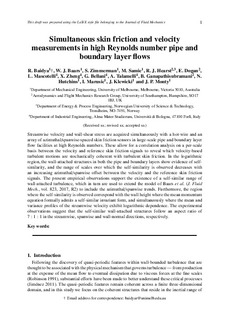| dc.contributor.author | Baidya, Rio | |
| dc.contributor.author | Baars, W. J. | |
| dc.contributor.author | Zimmerman, Spencer | |
| dc.contributor.author | Samie, Milad | |
| dc.contributor.author | Hearst, R. Jason | |
| dc.contributor.author | Dogan, Eda | |
| dc.contributor.author | Mascotelli, Lucia | |
| dc.contributor.author | Zheng, X | |
| dc.contributor.author | Bellani, Gabriele | |
| dc.contributor.author | Talamelli, A. | |
| dc.contributor.author | Ganapathisubramani, Bharathram | |
| dc.contributor.author | Hutchins, Nicholas | |
| dc.contributor.author | Marusic, Ivan | |
| dc.contributor.author | Klewicki, Joe | |
| dc.contributor.author | Monty, Jason P | |
| dc.date.accessioned | 2019-05-28T12:33:28Z | |
| dc.date.available | 2019-05-28T12:33:28Z | |
| dc.date.created | 2019-05-26T11:06:35Z | |
| dc.date.issued | 2019 | |
| dc.identifier.citation | Journal of Fluid Mechanics. 2019, 871 377-400. | nb_NO |
| dc.identifier.issn | 0022-1120 | |
| dc.identifier.uri | http://hdl.handle.net/11250/2599266 | |
| dc.description.abstract | Streamwise velocity and wall-shear stress are acquired simultaneously with a hot-wire and an array of azimuthal/spanwise-spaced skin friction sensors in large-scale pipe and boundary layer flow facilities at high Reynolds numbers. These allow for a correlation analysis on a per-scale basis between the velocity and reference skin friction signals to reveal which velocity-based turbulent motions are stochastically coherent with turbulent skin friction. In the logarithmic region, the wall-attached structures in both the pipe and boundary layers show evidence of self-similarity, and the range of scales over which the self-similarity is observed decreases with an increasing azimuthal/spanwise offset between the velocity and the reference skin friction signals. The present empirical observations support the existence of a self-similar range of wall-attached turbulence, which in turn are used to extend the model of Baars et al. (J. Fluid Mech., vol. 823, p. R2) to include the azimuthal/spanwise trends. Furthermore, the region where the self-similarity is observed correspond with the wall height where the mean momentum equation formally admits a self-similar invariant form, and simultaneously where the mean and variance profiles of the streamwise velocity exhibit logarithmic dependence. The experimental observations suggest that the self-similar wall-attached structures follow an aspect ratio of 7:1:1 in the streamwise, spanwise and wall-normal directions, respectively. | nb_NO |
| dc.language.iso | eng | nb_NO |
| dc.publisher | Cambridge University Press | nb_NO |
| dc.title | Simultaneous skin friction and velocity measurements in high Reynolds number pipe and boundary layer flows | nb_NO |
| dc.type | Book | nb_NO |
| dc.description.version | acceptedVersion | nb_NO |
| dc.source.pagenumber | 377-400 | nb_NO |
| dc.source.volume | 871 | nb_NO |
| dc.source.journal | Journal of Fluid Mechanics | nb_NO |
| dc.identifier.doi | 10.1017/jfm.2019.303 | |
| dc.identifier.cristin | 1700261 | |
| dc.description.localcode | © 2019. This is the authors’ accepted and refereed manuscript to the article. Locked until 21.01.2020 due to copyright restrictions. | nb_NO |
| cristin.unitcode | 194,64,25,0 | |
| cristin.unitname | Institutt for energi- og prosessteknikk | |
| cristin.ispublished | true | |
| cristin.fulltext | postprint | |
| cristin.qualitycode | 2 | |
